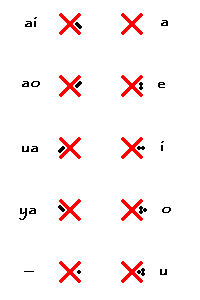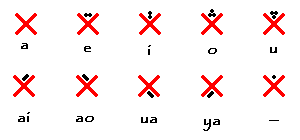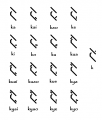Kala writing
From FrathWiki
Jump to navigationJump to search
Moya
Moya is an abugida, or abjad used to represent the Kala language.
Notable features
- Moya is written vertically, in columns running from left to right, when necessary, or for aesthetic reasons it can be written horizontally.
- The word moya not only refers to the script but also means "to write, character, letter" in Kala.
- Moya contains 14 consonant syllables, two vowel markers and ten vowel diacritics.
Moya Consonants, or Syllables
- Looking closely, you will notice that the symbols are arranged by phonetic relation, making Moya semi-featural.
Vowels (Diacritics)
- The vowels vary in direction between the two modes, vertical (ukaha) and horizontal (kalai).
- The ukaha mode vowels are turned 90° from their position in the kalai mode.
Ukaha vowels
Kalai vowels
Notes
- Full vowel indication (vocalization) can be added, by means of vowel diacritics, but this is only done to eliminate confusion.
- The script can also be written horizontally, but this is only done to save space.
- There is very little punctuation used in Kala, pauses, stops and questions are understood through the use of context and particles.
- Most often the vowels are not marked, the single diagonal mark is used to show that a vowel begins or ends the word, and is also used to connect graphemes that otherwise would not connect based on the normal methods of connecting.
Tables & Charts
Ka Table
- The ka syllable with all possible vowel combinations and permutations.
- Whenever a word ends in a vowel the pekoli (tail-mark) is present and will 'carry' the final vowel.
- If the consonant is labialized or palatalized those pehim (little marks) will be marked on the consonant.
- Note the kyao & kuai syllables.





